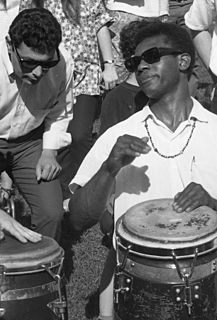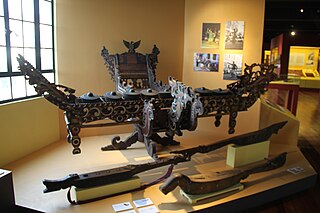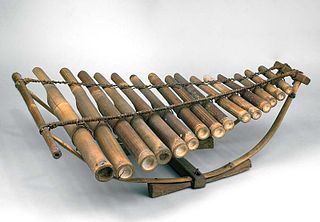
A percussion instrument is a musical instrument that is sounded by being struck or scraped by a beater including attached or enclosed beaters or rattles struck, scraped or rubbed by hand or struck against another similar instrument. Excluding zoomusicological instruments and the human voice, the percussion family is believed to include the oldest musical instruments.

A drummer is a percussionist who creates music using drums.

The xylophone is a musical instrument in the percussion family that consists of wooden bars struck by mallets. Like the glockenspiel, the xylophone essentially consists of a set of tuned keys arranged in the fashion of the keyboard of a piano. Each bar is an idiophone tuned to a pitch of a musical scale, whether pentatonic or heptatonic in the case of many African and Asian instruments, diatonic in many western children's instruments, or chromatic for orchestral use.
Music of Malaysia is the generic term for music that has been created in various genres in Malaysia. A great variety of genres in Malaysian music reflects the specific cultural groups within multiethnic Malaysian society: Malay, Chinese, Indian, Dayak, Kadazan-Dusun, Bajau, Orang Asli, Melanau, Kristang and others.

Kulintang is a modern term for an ancient instrumental form of music composed on a row of small, horizontally laid gongs that function melodically, accompanied by larger, suspended gongs and drums. As part of the larger gong-chime culture of Southeast Asia, kulintang music ensembles have been playing for many centuries in regions of the Eastern Indonesia, Southern Philippines, Eastern Malaysia, Brunei and Timor, Kulintang evolved from a simple native signaling tradition, and developed into its present form with the incorporation of knobbed gongs from Sundanese people in Java Island, Indonesia. Its importance stems from its association with the indigenous cultures that inhabited these islands prior to the influences of Hinduism, Buddhism, Islam, Christianity or the West, making Kulintang the most developed tradition of Southeast Asian archaic gong-chime ensembles.
The music of Cambodia is derived from a mesh of cultural traditions dating back to the ancient Khmer Empire, India, China and the original indigenous tribes living in the area before the arrival of Indian and Chinese travelers. With the rapid Westernization of popular music, Cambodian music has incorporated elements from music around the world through globalization.

A piphat is a kind of ensemble in the classical music of Thailand, which features wind and percussion instruments. It is considered the primary form of ensemble for the interpretation of the most sacred and "high-class" compositions of the Thai classical repertoire, including the Buddhist invocation entitled sathukan as well as the suites called phleng rueang. It is also used to accompany traditional Thai theatrical and dance forms including khon, lakhon, and shadow puppet theater.
An indoor percussion ensemble or indoor drumline is type of marching ensemble that utilizes the battery and front ensemble instruments. It differs itself from a traditional percussion ensemble in that it focuses not only on musical performance, but on theatrics and marching as well giving it the nickname "musical theatre." Although most indoor percussion ensembles are affiliated with high schools, there are also many independent groups that draw participants from a large area and are independently funded. Independent groups typically start rehearsing in October, while high school groups typically start after their fall marching band season ends. Because of this, the activity is often called winter percussion or winterline.

The Pinpeat is the largest Khmer traditional musical ensemble. It has performed the ceremonial music of the royal courts and temples of Cambodia since ancient times. The orchestra consists of approximately nine or ten instruments, mainly wind and percussion. It accompanies court dances, masked plays, shadow plays, and religious ceremonies. This ensemble is originated in Cambodia since before Angkorian era.

In a marching band or a drum and bugle corps, the front ensemble or pit is the stationary percussion ensemble. This ensemble is typically placed in front of the football field, though some groups will work the front ensemble into a tight pod onto the marching field. Some high school marching bands opt not to march any percussion instruments, but instead have a "full" front ensemble.

Ching are finger cymbals played in Cambodian and Thai theater and dance ensembles.

A Calung is a bamboo tube xylophone used in the Indonesian music of Sundanese, Banyumasan and Balinese.
Traditional Thai musical instruments are the musical instruments used in the traditional and classical music of Thailand. They comprise a wide range of wind, string, and percussion instruments played by both the Thai majority as well as the nation's ethnic minorities.

The ranat ek is a Thai musical instrument in the percussion family that consists of 21 wooden bars suspended by cords over a boat-shaped trough resonator and struck by two mallets. It is used as a leading instrument in the piphat ensemble.

The Roneat Ek or Roneat Aek is a xylophone used in the Khmer classical music of Cambodia. It is built in the shape of a curved, rectangular shaped boat. It has twenty-one thick bamboo or hard wood bars that are suspended from strings attached to the two walls. They are cut into pieces of the same width, but of different lengths and thickness. Originally these instruments were highly decorated with inlay and carvings on the sides of the sound box. Now they are simpler. The Roneat is played in the Pinpeat ensemble. In that ensemble, sits on the right of the Roneat Thung, a lower-pitched xylophone. The roneat ek is the analogous equivalent to the Thai xylophone called ranat ek, and the Burmese bamboo xylophone called "pattala".

The Roneat Thung or Roneat Thum is a low-pitched xylophone used in the Khmer classical music of Cambodia. It is built in the shape of a curved, rectangular shaped boat. This instrument plays an important part in the Pinpeat ensemble. The roneat Thung is placed on the left of the roneat ek, a higher-pitched xylophone. The Roneat Thung is analogous to the ranat thum of Thai.

Roneat is the generic Khmer word for referring to several types of xylophones used in traditional Cambodian music; the pinpeat and mohaori.

Mohaori is one of the traditional musical ensembles of Cambodia. This traditional ensemble is known in full name as Vung Phleng Mohaori (វង់ភ្លេងមហោរី), literally means Mohaori Musical Ensemble. It composed of many kinds of musical instruments, but today it is more specifically applied to a small ensemble of wind, stringed, and percussion musical instruments.

Tanjidor is a traditional Betawi musical ensemble developed in Jakarta, Indonesia. This musical ensamble took form of a modest orchestra, and was developed in the 19th century, pioneered by Augustijn Michiels or better known as Major Jantje in the Citrap or Citeureup area on the outskirt of Batavia.














